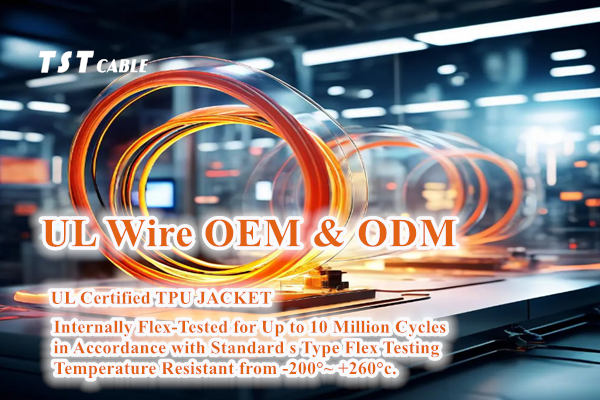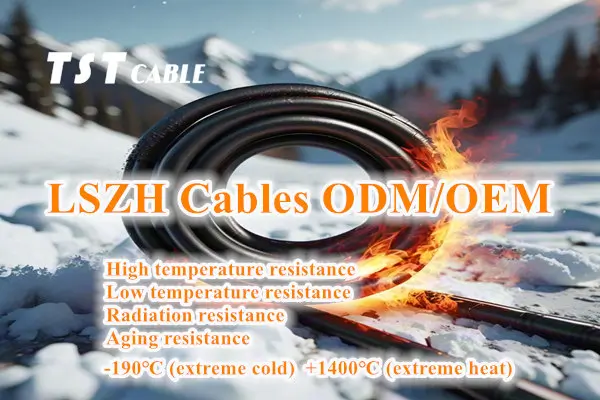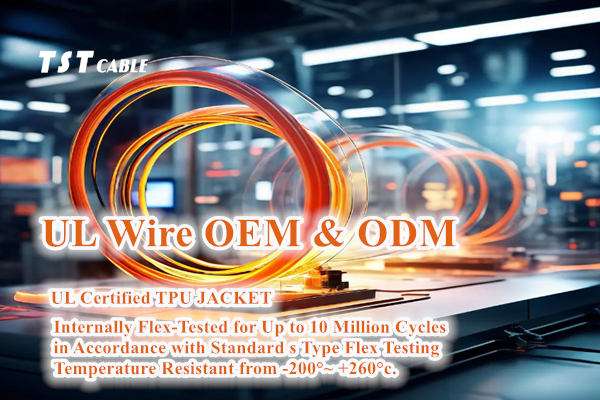AWG Wire UL 1581 Standard for Electrical Wires, Cables, and Flexible Cords

UL1581 standard is a widely recognized wire and cable test standard developed by Underwriters Laboratories (UL). This standard covers the requirements for electrical performance, mechanical performance, combustion performance and other aspects of wire and cable products.
It is mainly used in the power industry, data communication industry, urban rail transit industry, machinery, energy, oil and gas, military industry, medical industry, construction, automotive industry and shipbuilding industry. Today, TST CABLES will take you to learn about the UL1581 test standard and the flame retardant grade classification of UL1581 standard cables.
Introduction to UL1581 standard
UL1581 is a comprehensive wire and cable test standard designed to ensure the safety and reliability of wires and cables.
Purpose: To evaluate the performance of wires and cables to ensure that they can work safely and reliably under various conditions of use.
Scope of application: Applicable to all types of wires, cables and cords, including but not limited to wires and cables in construction, industrial, commercial and residential applications.
UL1581 certification significance
UL1581 certification is very important for wire and cable manufacturers and consumers.
UL1581 certification can obtain the UL certification mark, which is an internationally used certification mark and has an important impact on the promotion and sales of products.
Main requirements of the UL1581 standard
Construction and material requirements
Specify the construction of wires and cables and the materials used.
Including conductors (usually copper or aluminum), insulation layers, sheaths, fillers, etc.
Ensure that wires and cables have sufficient electrical insulation, heat resistance, abrasion resistance and flame retardancy.
UL1581 cable electrical performance
Test and evaluate the electrical performance of wires and cables.
Test contents include:
Zero voltage current, dielectric strength, corona resistance, ground resistance, to ensure the performance and safety of wires and cables in normal use and rated voltage range.
UL1581 flammability and fire resistance
Emphasize the requirements for flammability and fire resistance.
Combustion tests must be carried out under specific conditions to verify flame retardancy and flame propagation performance.
UL1581 tests include:
Vertical combustion test
Horizontal combustion test
Vertical fire resistance test
Evaluate the combustion behavior and flame propagation rate of wires and cables to ensure safety in the event of a fire.
UL1581 standard physical properties
Cover the physical performance requirements of wires and cables, such as mechanical strength, abrasion resistance, flexibility, etc.
Ensure the durability and reliability of wires and cables during normal use, installation and maintenance.
UL1581 standard environmental adaptability
Requires consideration of the adaptability of wires and cables under different environmental conditions.
Including indoor and outdoor use, low and high temperature environments, the influence of humidity and chemicals, etc.
Through testing and evaluation, ensure the performance and safety of wires and cables under different environmental conditions.
UL1581 standard test items
Detailed description of test items
- Conductor resistance test
Purpose: Measure the resistance value of the conductor to ensure that it is within the allowable resistance range.
Method: Use a resistance tester to measure the DC resistance of the conductor at a certain temperature. - Conductor insulation thickness test
Purpose: Check whether the thickness of the insulation layer meets the regulations to ensure electrical performance and safety.
Method: Take samples at different locations of the insulation layer and use a microscope or other tools to measure the thickness. - Outer sheath test
Purpose: Evaluate the quality and performance of the outer sheath material to ensure that it has sufficient protection function.
Method: may include appearance inspection, thickness measurement, hardness test, etc. - Lay test
Purpose: Measure the lay distance of wires and cables to ensure the uniformity and stability of the lay.
Method: Determine the lay distance by measuring the distance between the twisted conductors. - Burning test
Purpose: Evaluate the flame retardant properties of wires and cables.
Method: Includes vertical burning test, horizontal burning test and vertical fire resistance test, etc.
Vertical burning test (CM, CMR, CMP): Test the burning performance of wires and cables when placed vertically.
Horizontal burning test (CMX): Test the burning performance of wires and cables when placed horizontally.
Vertical fire resistance test: Test the fire resistance of wires and cables when placed vertically. - Withstand voltage test
Purpose: Test the performance of the insulation material of wires and cables under high voltage.
Method: Apply an AC voltage higher than the rated voltage to both ends of the wires and cables for a certain period of time to observe whether there is a breakdown phenomenon. - Spark test
Purpose: Evaluate the reaction of wires and cables under the action of arcs or sparks.
Method: Simulate electric arc or spark on the surface of wire and cable, and observe the reaction of wire and cable. - Insulation resistance test
Purpose: Measure the insulation resistance of wire and cable to ensure good electrical insulation performance.
Method: Apply DC voltage to both ends of wire and cable, measure the leakage current flowing through, and calculate the insulation resistance. - Tensile test before and after aging
Purpose: Evaluate the changes in mechanical properties of wire and cable before and after aging.
Method: Perform tensile tests before and after aging treatment to compare the changes in tensile strength and elongation. - Anti-ultraviolet light test
Purpose: Evaluate the durability of wire and cable under ultraviolet light.
Method: Expose wire and cable to ultraviolet light for a certain period of time, and observe the changes in appearance and mechanical properties. - Oil immersion test
Purpose: Test the stability of wire and cable in oil environment.
Method: Soak wire and cable in oil for a certain period of time, and then measure the changes in performance. - Insulation layer tightness test
Purpose: Ensure the tightness of the insulation layer to avoid moisture penetration.
Method: May include water immersion test, etc. - Surface printing firmness test
Purpose: To ensure that the markings on the wires and cables are not easy to fall off.
Method: Test the firmness of the printing by friction or solvent immersion. - Tensile test
Purpose: To evaluate the tensile strength of wires and cables.
Method: Apply tension at both ends of the wires and cables to measure the maximum tension when they break.
UL1581 test standard and classification of flame retardant grades of fireproof cables
CM (Commercial Grade): Applicable to indoor horizontal wiring, but not to vertical wiring between floors.
CMX (Horizontal Flame Test for Single Insulated Wires and Cables): Applicable to horizontal flame test of single insulated wires and cables.
CMR (Riser): Applicable to vertical wiring between floors.
CMP (Plenum): Applicable to cables in plenum spaces, requiring the highest flame retardant performance.
Commercial Grade-CM Grade (Vertical Flame Test)
This is a commercial grade cable in the UL standard, and the applicable safety standard is UL1581. The test stipulates that multiple samples are laid on a vertical 8-foot-high bracket and burned with a specified 20KW strip torch (70,000 BTU/Hr) for 20 minutes. The qualified standard is that the flame cannot spread to the upper end of the cable and extinguish itself. UL1581 is similar to IEC60332-3C, except that the number of cables laid is different. Commercial-grade cables have no smoke density specifications and are generally only used for horizontal wiring on the same floor, not for vertical wiring on the floor.
General-purpose grade-CMG grade (vertical burning test)
This is a general-purpose cable in the UL standard, and the applicable safety standard is UL1581. The test conditions of commercial and general grades are similar, and they are both approved for use in Canada and the United States. General-grade cables have no smoke density specifications and are generally only used for horizontal wiring on the same floor, not for vertical wiring on the floor.
Home-grade-CMX grade (vertical burning test)
This is a home-grade cable in the UL standard, and the applicable safety standards are UL1581, VW-1. The test requires that the sample be kept vertical, and the test torch burns (30,000 TU/Hr) for 15 seconds, then stops for 15 seconds, and repeats 5 times. The qualified standard is that the residual flame cannot exceed 60 seconds, the sample cannot be burned by more than 25%, and the cotton pad at the bottom cannot be ignited by falling objects. UL1581-VW-1 is similar to IEC60332-1, except that the burning time is different. This level also has no smoke or toxicity specifications and is only used in home or small office systems where a single cable is laid. Such cables should not be laid in bundles and must be sleeved. Smoke density, halogen content and toxicity level.
Cooperate with TST CABLES to customize cables that meet UL1581 test standards
The UL1581 standard is a strict test standard that ensures the safety and reliability of TST CABLES wires and cables. Through this series of tests, the performance of wires and cables under various conditions of use can be verified, thereby protecting people’s lives and property. Cable manufacturers and users should be familiar with these standards to ensure that the wires and cables used meet the relevant safety requirements.
Our high-temperature cables have been verified by strict UL1581 test standards to ensure their excellent electrical performance, flame retardancy and mechanical strength. From high temperature resistance to low smoke and halogen-free, from tensile strength to chemical corrosion resistance, every test proves that our cables still perform well in extreme environments.
We understand the importance of safety. This high temperature cable has passed rigorous vertical combustion tests (CM, CMR, CMP), ensuring that it can effectively prevent the spread of flames in emergency situations such as fires, providing you and your team with the greatest degree of safety.
Whether on industrial production lines or in complex outdoor environments, TST CABLES UL high temperature cable series products can do the job. It is suitable for aerospace, oil and gas, electric power, automotive manufacturing and other fields to meet your various needs for high-performance cables.
Also available in:
English



